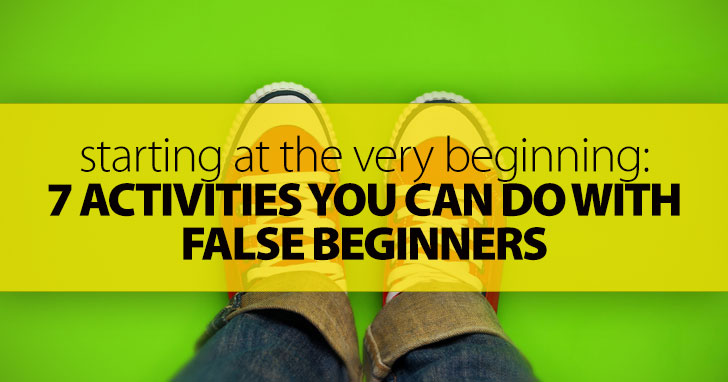From ESL Zero to Hero: How to Teach Absolute Beginners


Rarely do students enter a beginning level ESL class in the United States that have no knowledge of English. Note I said rarely. Because it does happen. I have had a handful of students travel overseas to study English with no previous knowledge of the language. They couldn’t count. They couldn’t order a meal. Nothing. Teaching a class like this, one often referred to as a false beginner class, can be a challenge. It can be a real struggle to know how to begin teaching students at this level. Thankfully, there are activities that work with students just getting introduced to English. If you find yourself in the position of teaching false beginners, here are some activities you can try.

Music is a universal language of sorts, and when vocabulary and language concepts are put to song, they are just easier to remember. So choose a song to teach your students. You might choose one that has vocabulary that they will be learning or should already know. You might choose one that shows a particular grammar concept. You might choose a children’s song or a contemporary song. Whatever song you choose, be sure to write out the lyrics and have your students copy them. Review words, especially content words. Point out any grammar patterns in the song. (They can be as simple as how to form the present tense.) And sing your heart out. The more enthusiasm you put into your musical instruction, the more enthusiasm you will get back from your students. And you get bonus points if you can accompany them on an instrument in class.
If you speak your students’ first language, you may be able to do some of your instruction in that language. Though I’m more in favor of immersion instruction most of the time, sometimes it’s okay to bring the L1 in. When you are teaching false beginners, the time is right to open those doors and welcome L1 into the classroom. You can also let your students use bilingual dictionaries as they lay down the basics of English. This will help them get a foundation of vocabulary knowledge upon which you can build.
If you haven’t used TPR before, you should make a point of using it now. The basic premise behind TPR is the teacher instructs in English and students make a physical response to that instruction. You might give your students commands like stand up, sit down, pick up your pencil, etc. As you do, students will begin to learn the vocabulary and perhaps the grammar you are using in your instruction. Make sure if you use TPR that you are also writing new vocabulary on the board and having students copy the words into their notebooks even if they aren’t exactly sure what they are writing. They will still absorb some of the information, and their subconscious will be hard at work deciphering what they wrote down.
Have you thought about teaching ESL classes as a kind of acting job? How many times have you had to pantomime a word or language concept for your students? Acting out in the ESL classroom is never more necessary than with false beginners. The more exaggerated you are in your movements and gestures, the easier time they will have understanding your meaning. Don’t stop with simply acting out words you are trying to teach, either. Develop a repertoire of gestures for instructional phrases such as repeat after me, your turn, listen closely, etc. If you are consistent with your instructional gestures, your students will be able to follow your directions even if they don’t understand the words you are using to give your instructions.
Memorized dialogues are helpful when working with absolute beginners. Simple conversations that introduce key vocabulary and simple grammar structures that are also practical and useful in real life situations can be very useful for false beginners. And since these dialogues should be super simple, you can write your own to boot. Once you have a short dialogue of five to eight sentences, read it to your students so they can hear the correct pronunciation. Read it again and have your students repeat each line after you. Finally, put students in groups of two or three and have each student read the conversation. As they read, the other students follow along on their papers and listen for mistakes. If the speaker makes a mistake, his group members should stop him, and he should start the dialogue over from the beginning. Make sure each person has a chance to read the dialogue and have his group members listen form mistakes before going on to the next activity.
The more involved you can get your students senses, the easier time they will have learning what you are teaching. When possible, bring in elements that stimulate the senses of sight, hearing, touch, taste, and smell to enrich your lesson. For example, you might bring in visual aids such as flash cards or pictures printed from the internet or copied from a book. You might have the objects themselves in your classroom when you can, objects such as baseballs, flowers, pencils, and chairs. Students can handle these learning props engaging their sense of touch. While you’re at it, have students smell that flower or listen to you write with a pencil or piece of chalk. The more connections you can make between target vocabulary and your students’ brain sensors, the easier they will understand what you are saying and the better they will remember what you are teaching.
When a student is at the very beginning of his English language learning journey, it is very easy to get discouraged. Take time to review with your class every day what they have learned. This does two things. First it solidifies the concepts in their minds. More importantly, though, it gives them a sense of accomplishment and reminds them of how far they have already come. False beginners need reminders of the steps they have taken or discouragement and burnout won’t be far off. The more you can encourage your students in this way, the happier and more successful they will feel.
Start with these seven simple strategies and your students will be speaking English in no time.